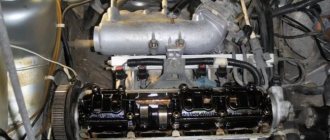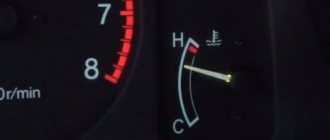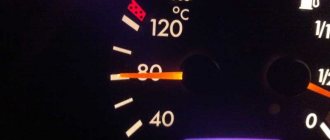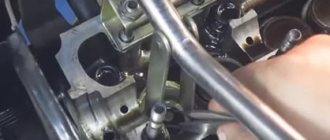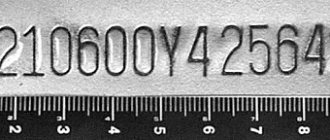The problem of engine overheating is well known to many owners of domestic cars. The VAZ 2110 (2111, 2112) and 2113 (2114, 2115) lines were equipped with small-volume cooling radiators, so when driving for a long time in hot summer weather, the VAZ “normally” heats up to 105-108 degrees. But if the temperature goes through the roof even after a short trip, this is a reason to think about problems with the cooling system.
The consequences of severe overheating are even more severe: the cylinder head and cylinder block are deformed and sometimes crack. An engine that has survived this can no longer be repaired.
[custom_ads_shortcode1]
What should the temperature be?
The temperature arrow tends to the red zone - soon overheating. According to the international automobile convention of December 1, 1992, where 92 representatives of the auto industry gathered, it was decided to establish a single standard for engine temperature in operating condition.
This indicator is 90 degrees Celsius with a maximum permissible deviation of no more than 3 degrees Celsius.
With the development of the automotive industry and a sharp leap in technology in the 2000s, in 2004 it was decided to revise this indicator. So, having considered all the facts and analyzed the design features of many cars, it was decided to establish a floating indicator with marginally acceptable standards, which, today, is 85-105 degrees Celsius.
[custom_ads_shortcode2]
Normal temperature readings
For all cars the operating temperature is approximately the same. This is due to the fact that in 1992, manufacturers established a single standard. According to it, the temperature at which the engine will operate without failures fluctuates around 90 degrees. The permissible error is 3 degrees in each direction.
In 2004, this figure was revised, as the automotive industry has made great strides forward. Then a range from 85 to 105 degrees appeared, acceptable for many cars. It was he who was guided by when creating the VAZ-2114. The injector of this model can operate at temperatures from 87 to 103 degrees. This range applies to modifications with 8 and 16 valves with a volume of 1.6 liters.
Operating range on the VAZ-2114
If we consider cars produced at the AvtoVAZ plant, including the VAZ-2114, then the operating temperature range for engines is considered to be 87-103 degrees Celsius. If we consider this issue from the point of view of functionality, then this is the optimal indicator.
If the temperature drops below the limit level, then the Samara-2 engine loses dynamics and power, and if it is higher, it can simply boil and cause great damage. Therefore, if malfunctions associated with the cooling system occur, they must be eliminated as soon as possible.
[custom_ads_shortcode3]
A high operating temperature of the engine may also indicate serious malfunctions. But in most cases, the VAZ 2114 heats up for minor reasons, including:
- thermostat malfunction;
- malfunction of the coolant temperature sensor (DTOZH);
- malfunction of the high pressure valve in the coolant tank cap;
- clogged radiator.
Measures to take if the engine overheats
In an engine, within the cooling system's range, the hottest components are the surfaces adjacent to the combustion chambers. Designers and engineers were able to show that fluids circulating in these hot groups could effectively remove excess heat. In this case, the same heat transfer reaches such a volume that a boiling core can form in the channels or circuits through which the liquid circulates.
In turn, this instantly reduces the heat exchange processes between the liquid and the hot metal. After this, the engine continues to warm up. Further heating and reduction in the density of the refrigerant due to boiling causes other nearby hot spots to boil. The pressure in the cooling system quickly increases and is then released through the radiator cap.
This engine overheating and excessive thermal stress can lead to serious problems. If the VAZ engine warms up, there is a certain risk of misalignment of the cylinder head and liners, ignition is possible in advance, low fuel efficiency threatens, erosion processes appear around the liners, as well as heads and pumps.
If the temperature sensors are working properly, then you can see on the dashboard that the VAZ is heating up. If while driving you notice that the temperature gauge has started to move safely into the red zone, you must stop the car and activate the emergency stop signal. Then you need to open the car hood and check the coolant level.
If you see from the sensor that the engine is overheated and clouds of steam are actively coming out from under the hood, then you need to turn off the engine and wait until the steam stops flowing. And only then you need to open the hood and check the fluid level. Do not open the expansion tank cap while the engine is running, as there is a risk of being scalded by boiling water.
For safety reasons, do not lean directly on the neck of radiators or tanks, as this increases the risk of steam burns. When opening the expansion tank cap, protect your hands if possible by wrapping the cap with a rag or cloth.
Thermostat malfunction
The thermostat is one of the weak points of the VAZ. It can be found on the right side of the cylinder block when facing the vehicle. To check the thermostat, you need to warm up the car until the fan turns on and touch the lower radiator hose with your hand. If the thermostat is working properly, it should be warm.
Removing the thermostat on a VAZ 2114 The cold pipe indicates that the thermostat is stuck in the closed position. In this case, the coolant circulates around the radiator, in a small circle. Heat exchange is disrupted - the engine quickly overheats. The problem is solved by replacing the thermostat.
[custom_ads_shortcode1]
Instructions for replacing the TOZh sensor with your own hands
Replacing the DTOZH is carried out as follows:
- First you need to turn off the ignition and open the hood of your car.
- In addition, under the drain hole of the engine radiator device, it is necessary to replace the container; all the coolant will collect in it. Open the plug and drain the antifreeze, then find the DTOZH and disconnect the connector from it.
- Using a wrench, you will need to disassemble the controller. The device is removed from the installation site. When removing, the rubber gasket is visible; do not lose it when removing the regulator. If you notice that the rubber band is worn out, it will need to be replaced.
- Next, you will need to install the new controller in the mounting location. Using a wrench, screw the device in completely, then connect the connector to the wire that was disconnected during disassembly. Now you just need to pour working fluid into the radiator device and turn on the ignition, start the engine and check the operation of the device.
DTOZH malfunction
If the fan does not turn on at 90-95 degrees or turns on later than necessary, this may indicate a failure of the DTOZH. The sensor is inexpensive and breaks often, so you should always keep a spare part in the glove compartment. The DTOZH is also located to the right of the cylinder block, identified by a chip with three wires. When replacing the sensor, you need to make sure that the wires are intact: their breakage can also cause overheating.
We recommend: Recommendations for replacing spark plugs on a VAZ 2114
[custom_ads_shortcode2]
Cooling system problems
If you notice that the operating temperature of the VAZ 2114 engine does not correspond to the norm (both up and down), then first of all the reason should be looked for in the cooling system.
Its most important components that directly affect engine temperature are:
- radiator;
- pipes;
- water pump;
- thermostat.
Cooling system VAZ 2114
Thus, the first thing worth checking when the engine overheats is the radiator.
There are only 3 main reasons why it may not function correctly:
- Lack of coolant in the system.
- Cooling grid clogged.
- Leak.
In the first case, you should check the fluid level and, if necessary, top it up. In the second case, you will have to dismantle the radiator and clean it (both internal and external purging). In the third case (if a leak is detected), you can either use soldering or use a special sealing compound for radiators, and then add coolant to the normal level.
Antifreeze level VAZ 2114
In some, especially advanced, cases, a complete replacement of the radiator may be required. It is not worth saving and trying to restore a “dead” radiator, since its incorrect operation can lead to severe wear and even damage to the engine, as a result of which a major repair will cost a much larger sum.
The next thing you have to check when troubleshooting is the cooling system pipes. With prolonged use, they can become “obsolete” with the further formation of cracks, which may result in a leak of coolant. If it turns out that the pipes have indeed leaked, they should simply be replaced with new ones, and the problem will be solved.
VAZ 2114 pipes
If it turns out that both the radiator and the pipes are working properly, you should check the pump (liquid pump). This can be done by replacing it with a new one of a similar model. If after such a replacement the operating temperature of the VAZ 2114 8-valve engine returns to normal, then this means that this was the reason.
Radiator clogged
The radiator can be clogged from the outside and inside. External contamination is associated with dust and other debris, as well as insects, entering the honeycombs. This worsens heat transfer and is manifested by frequent operation of the fan and a long operating time.
Clogged engine radiator honeycombs The problem can be solved by a good wash with a high pressure washer. If the radiator has been in use for a long time, the car cools and heats up worse due to deformation of the honeycombs. You can “cure” this problem by replacing the radiator.
The radiator rarely clogs from the inside. This usually occurs due to poor quality antifreeze, driving on water, or as a “side effect” of radiator sealants. The presence of this problem is indicated by the coolant: it becomes cloudy, oil stains and solid particles are visible in it. Flushing the cooling system of the VAZ 2114 is carried out by completely draining the antifreeze with distilled water with the addition of radiator cleaning agents.
According to statistics, three-quarters of the answers to the question why the engine of the “four” heats up are associated with one of the malfunctions listed above. You can diagnose and eliminate them yourself without involving the services of a car service. If none of the above methods solves the problem, it is better to contact a specialist for diagnosis.
Other reasons for overheating of the VAZ-2114:
- dashboard malfunction;
- pump malfunction;
- Leaking cylinder head gasket.
[custom_ads_shortcode1]
What to do if your car overheats in a traffic jam
When a car is driven for a long time in a lower gear, the engine operates with increased power, which in itself leads to overheating. To this should be added the lack of counterflow of air necessary to cool the radiator. What to do?
The main thing is not to panic. Brief overheating isn't a big deal, but if you see that your car isn't cooling down, it's time to take action.
Important: do not turn off the engine unless absolutely necessary. That's right - no extremes. A stalled and overheated engine is an almost 100% guarantee of repair. It would take quite a long time to describe what is happening in the engine in this case (rotating the liners along with the crankshaft, the next time you start the engine - the least possible problem), take it on faith.
Important: Do not attempt to pour water on the engine or pour cold water into the radiator. There is only one result: repair. Additionally, you may be working so hard that you can't help but replace the block and cylinder head. Another “charm” of cold water is microcracks inside the block. Finding and fixing it will be very, very difficult, if not impossible. The car is overheated, try stopping. If it doesn't work, don't panic and don't pay attention to others, it's important to preserve the engine. We stopped at idle, turned on the heater at full power and began to wait. If the situation does not improve after 5-10 minutes, turn off the engine.
It’s a good idea to open the hood; the main thing is not to forget to put the parking brake on the car in a panic. The only reason to stop the engine immediately is if there is a puff of steam coming from under the hood. Most likely, the cooling pipe has burst, and further operation of the engine will only worsen the situation.
So, the engine overheats, if you look closely. Now you know why the engine overheats and how to deal with it.
With the onset of warm weather, many drivers are faced with a malfunction of the VAZ cooling system with a very hot VAZ 2114 engine. There are several reasons for engine overheating. You need to understand the reasons and learn how to deal with overheating.
Dashboard malfunction
The cause of incorrect readings on the dashboard may be a factory defect or a huge number of electrical faults: from a bad ground on the ECU to a failure of the voltage stabilizer (“tablet”). This can be indicated by uneven changes in temperature readings (jumps), incorrect readings of other devices, or a discrepancy between turning on the fan and the temperature readings.
We recommend: Installing a turbine on an 8-valve VAZ 2114 engine. This malfunction is less problematic: the car does not actually heat up, but only for the computer. But she discovers other problems that also need to be solved.
[custom_ads_shortcode2]
What does an increase or decrease in this indicator lead to?
If the temperature drops below this norm, the engine will lose power and dynamics. As a result, the car will have a harder time picking up speed and consume more fuel. Especially often, a decrease in normal values occurs in winter, if the power plant is not warmed up enough or if the stove malfunctions. It is important to maintain the engine regularly to avoid this situation.
In summer, leaving the operating temperature range is more dangerous, especially if the engine overheats, which happens extremely often this season.
An increase in temperature leads to boiling of liquids in the engine, which causes irreparable damage to it.
The main problem with the engine reaching operating temperatures is related to changes in the properties of the oil:
- as it decreases, it becomes more viscous;
- when increasing liquid.
This may result in under or over lubrication of parts. It is much more dangerous if the oil becomes more liquid and loses its properties, since in this case friction occurs between the iron parts, leading to their wear.
Pump malfunction
The pump rarely fails completely, so the fault can be accurately diagnosed only after removal. The most common problem with it is the impeller breaking off. It can be solved by replacing the pump.
Other troubles include deformation of the pump gear and blades due to defects or mechanical wear. This fault is especially serious as it can cause the timing belt to become misaligned. And this is its uneven wear and the danger of breakage with all the sad consequences for the piston group.
[custom_ads_shortcode3]
The main reasons for tripling
If you say that your engine is not working, many will answer: the cylinder is not working. But this argument is not entirely correct, since the cylinder stops working normally. However, there may be several reasons for this:
- The valves are not suitable due to a long lack of adjustment;
- The ignition coil is faulty;
- The injectors are dirty or overfilled and must be replaced;
- The oxygen sensor stopped working;
- The air filter is broken or dirty.
- Broken ECU (electronic control unit);
- Compression in cylinders is too low;
- The spark plug is faulty or partially does not perform its function;
- The timing belt has come off or some links have simply slipped off;
- The high-voltage spark plug wire is damaged;
- DPKV (crankshaft position sensor) does not work);
Specifications
1.5l
The main difference between the VAZ 2114 engine and the 21083 engine, on the basis of which it was developed, was the use of an injection system instead of an obsolete carburetor and camshaft with modified phases. The connecting rods are attached to the pistons using a floating pin.
Download .xls file
xls
Download picture
Send by email
| Parameter | Meaning |
| Put into production | 1994 |
| Configuration | L4 |
| Volume, l | 1499 cm3 |
| Number of valves per cylinder | 2 |
| Piston stroke | 71 mm |
| Cylinder diameter | 82 mm |
| Compression ratio | 9.8 |
| Gas distribution mechanism | OHV |
| Rated power | 78 l. With. at 5400 rpm min. |
| Max. torque | 116 Nm at 3 thousand rpm. min. |
| Supply system | Injector |
| Fuel | AI 93 |
| Claimed gas mileage | 7.3 l/100 km combined cycle |
Installed on VAZ 2115, 21083, 21102, 21099, 21122, 2111, 2113, 21102, 21093.
1.6l
Thanks to the increase in height of the cylinder block (2.3 mm), it was possible to increase the piston stroke and engine volume to 1.6 liters. The designers have achieved greater throttle response and improved environmental performance of the VAZ 2114 engine.
The car received an increase in power (81 hp and 125 Nm of torque), but lost in efficiency. Now the consumption of AI 95 in the combined cycle is 7.6 l/100 km.
Download .xls file
xls
Download picture
Send by email
| OPTIONS | MEANING |
| Put into production | 2004 |
| Configuration | L4 |
| Volume, l | 1596 cm3 |
| Number of valves per cylinder | 2 |
| Piston stroke | 75.6 mm |
| Cylinder diameter | 82 mm |
| Gas distribution mechanism | OHV |
| Rated power | 81 l. With. at 5200 rpm min. |
| Max. torque | 125 Nm at 3 thousand rpm. min. |
| Supply system | Injector |
| Fuel | AI 95 |
| Claimed gas mileage | 7.6 l/100 km combined cycle |
| Parameter | Meaning |
| Put into production | 2004 |
| Configuration | L4 |
| Volume, l | 1596 cm3 |
| Piston stroke | 75.6 mm |
| Compression ratio | 9.6 |
The 1.6i engine was equipped with: VAZ 21112, 21101, 21121, 2113, 2115, Lada Granta and Lada Kalina.
16V 1.6i l VAZ 211440-24
The logical development of the Kalina engine was a sixteen-valve engine. VAZ 2114, equipped with a 124 engine, meets Euro-3 environmental requirements.
The piston stroke and cylinder diameter remained the same. Thanks to minor modifications, at 5 thousand rpm the engine develops maximum power of 89 hp. With. Consumption in the combined cycle was reduced to 7.5 liters. per hundred.
Download .xls file
xls
Download picture
Send by email
| OPTIONS | MEANING |
| Put into production | 2004 |
| Configuration | L4 |
| Volume, l | 1599 cm3 |
| Number of valves per cylinder | 4 |
| Piston stroke | 75.6 mm |
| Cylinder diameter | 82 mm |
| Compression ratio | 10-Mar |
| Gas distribution mechanism | OHV |
| Rated power, l. With. at 5 thousand rpm. | 89 |
| Max. torque, Nm at 3700 rpm. | 131 |
| Supply system | Injector |
| Fuel | AI 95 |
| Claimed gasoline consumption, l/100 km combined cycle | 7.5 |
16V 1.6i (124) was also installed on the models: VAZ 21124, 21123 Coupe, 21104, 21114.
see also
Comments 24
I changed the thermostat over the weekend: it turned out to be the reason. The operating temperature dropped to 92. Happy
